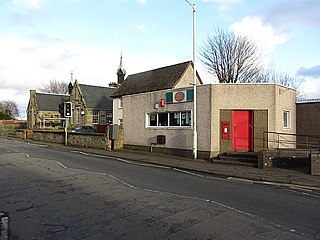
Kinglassie is a small village and parish in central Fife, Scotland. It is located two miles southwest of Glenrothes. It has a population of around 1,900 (mid-2020 est.) The civil parish has a population of 22,543.

Fife is a council area, historic county, registration county and lieutenancy area of Scotland. It is situated between the Firth of Tay and the Firth of Forth, with inland boundaries with Perth and Kinross and Clackmannanshire. By custom it is widely held to have been one of the major Pictish kingdoms, known as Fib, and is still commonly known as the Kingdom of Fife within Scotland. A person from Fife is known as a Fifer. In older documents the county was very occasionally known by the anglicisation Fifeshire.
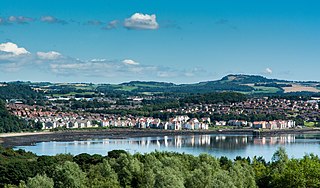
Dalgety Bay is a coastal town and parish in Fife, Scotland. According to Fife Council, the town is home to , making this the eighth-largest place in Fife. The civil parish has a population of 10,777.
Cupar is a town, former royal burgh and parish in Fife, Scotland. It lies between Dundee and Glenrothes. According to a 2011 population estimate, Cupar had a population around 9,000, making it the ninth-largest settlement in Fife, and the civil parish a population of 11,183. It is the historic county town of Fife, although the council now sits at Glenrothes.

Anstruther is a small coastal resort town in Fife, Scotland, situated on the north-shore of the Firth of Forth and 9 mi (14 km) south-southeast of St Andrews. The town comprises two settlements, Anstruther Easter and Anstruther Wester, which are divided by a stream, the Dreel Burn. With a population of 3,500, it is the largest community on the Firth of Forth's north-shore coastline known as the East Neuk. To the east, it merges with the village of Cellardyke.

Kelty is a former coal mining village located in Fife, Scotland. Lying in the heart of the old mining heartlands of Fife, it is situated on the Fife/Kinross-shire boundary and has a population of around 6,000 residents. This was nearer to 9,000 when the coal mining industry was still operational in late 1970s and early 1980s.
Barry is a small village in Angus, Scotland, on Barry Burn at the mouth of the River Tay. The recent completion of a bypass for the village on the A930 road from Dundee to Carnoustie is something that was originally planned before the Second World War. There is a water mill operated by the National Trust for Scotland. The village is served by Barry Links railway station. The village was formerly served by Barry primary school which closed in 2007.
Balmerino Abbey, or St Edward's Abbey, in Balmerino, Fife, Scotland, was a Cistercian monastic community which has been ruinous since the 16th century.
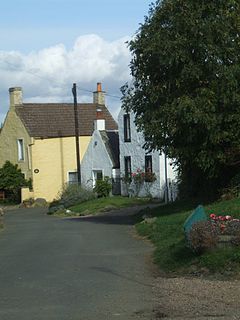
Balmerino is a small village and former monastic centre in Fife, Scotland. It is the home of Balmerino Abbey and the former abbots of Balmerino who were great regional landlords. It became a secular lordship in 1605 when the abbey's lands were transferred into a Barony and the title of Lord Balmerino was created. The already fire-damaged abbey was allowed to fall into ruin as it no longer had a function. The Abbey ruins and grounds are managed by the National Trust for Scotland and are famed for the ancient sweet chestnut tree and the display of aconites which flower in February.
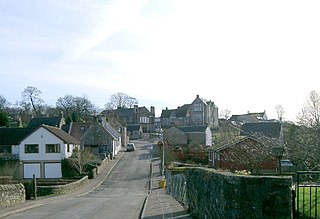
Saline is a village and parish in Fife, Scotland, situated 5 miles (8.0 km) to the north-west of Dunfermline. It lies in an elevated position on the western slopes of the Cleish Hills.

Auchtertool is a small village in Fife, Scotland. It is 4 miles west of Kirkcaldy. The name is from the Gaelic uachdar, meaning upland or heights above the Tiel burn. The Tiel Burn flows a few hundred yards south of the kirk and village, which was formerly known as Milton of Auchtertool. The parish belonged to the diocese of Dunkeld, having been given to Bishop Gregory by King David I in the twelfth century. Soon after, the church was given to the priory of Inchcolm.
John Hamilton of Blair (c.1638–1690)was a 17th-century Church of Scotland minister and bishop. He was a descendant of John Hamilton, Archbishop of St Andrews.
Forgan is a civil parish in the Scottish county of Fife. It extends 4 miles in length along the north coast of Fife and is at the southern mouth of the River Tay. It is bounded by the other Fife civil parishes of Ferry-Port on Craig, Leuchars and Balmerino. It contains the towns of Newport-on-Tay and Wormit. The roads and railways leading to the Tay Bridges pass through the parish.

Carnock is a village and parish of Fife, Scotland, 4+1⁄4 miles west of Dunfermline. It is 1+1⁄4 miles east of Oakley, Fife. The name of the village derives from Scottish Gaelic, from ceàrn ("corner"), with a suffix denoting a toponym, thus giving "[the] corner place". Carnock is known to have had military significance in antiquity. The civil parish had a population of 5,927 as of 2011.

Kingskettle or often simply Kettle is a village and parish in Fife, Scotland. Encompassed by the Howe of Fife, the village is approximately 5.5 miles (9 km) southwest of the nearest town, Cupar, and 22 miles (35 km) north of Edinburgh. According to the 2011 Census for Scotland, the Kettle parish had a population of 1,645, of which 1,002 lived in the village.

Flisk was a parish in Fife, Scotland.
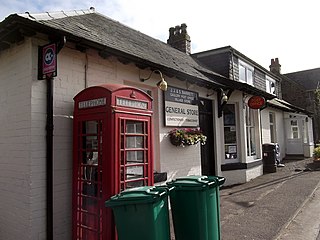
Gauldry, locally sometimes The Gauldry, is a village in Fife, Scotland. It is located 3 kilometres (1.9 mi) southwest of Newport on Tay, 2 kilometres (1.2 mi) south-east of Balmerino, and 1 kilometre (0.62 mi) south of Bottomcraig.
Logie is a parish and village in east Fife, Scotland, 5 miles north-east of Cupar.

St Mary Star of the Sea (Leith) Church is a Roman Catholic parish church in Edinburgh, Scotland. It is situated on Constitution Street in the Leith district and staffed by the Missionary Oblates of Mary Immaculate.














